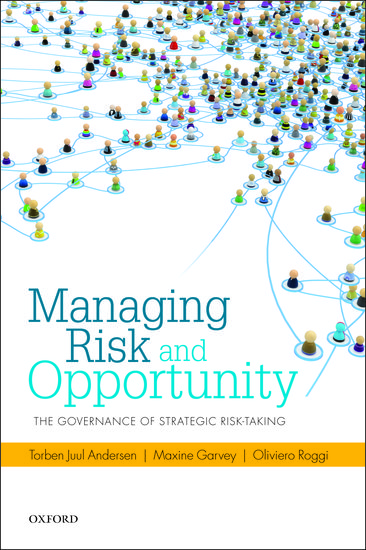This volume focuses on contemporary risk leadership issues based on recent research insights, but aims to avoid excessive technical language and mathematical formulas. Maria Zhivitskaya believes that the thoroughly researched and well-structured chapters mean this book should be mandatory reading for Risk Officers and Regulators.
 Managing Risk and Opportunity: the Governance of Strategic Risk Taking. Torben Juul Andersen, Maxine Garvey, and Oliviero Roggi. Oxford University Press. April 2014.
Managing Risk and Opportunity: the Governance of Strategic Risk Taking. Torben Juul Andersen, Maxine Garvey, and Oliviero Roggi. Oxford University Press. April 2014.
“Even if you are a sensible risk taker and measure risks well, you will be wrong a substantial portion of time. Sometimes, you will be wrong on the upside (you underestimate the potential for profit) and sometimes you will be wrong on the downside”.
Despite this gloomy warning carefully hidden on page 150, this book contains 176 pages of brilliantly written overview of the current thinking in risk management. The three authors – Torben Andersen, a Copenhagen Business School Professor of Strategy and Management; Maxine Garvey, a World Bank Senior Operations Officer; and Oliviero Roggi, a Professor of Finance from the University of Florence – represent academia and practice, and succeed in writing a book that will be of interest to both of these worlds.
The target audience is institutional managers, executives, and directors “wherever they operate around the world, according to the authors. However, the book is so relevant, timely, and informative that I hope its audience will be extended to regulators, consultants, and also included in the university curricula. They assume an intelligent reader, but do not take prior knowledge of specifics of risk management for granted. This does not mean that the book is a basic introduction to risk management, because they also succeed in deep dives into the important areas. There are some formulae, but one does not need to be an actuary to understand them, and indeed one of the most impressive aspects about the book is that it explains CAPM (Capital asset pricing model), Value at Risk, Risk-adjusted value of assets, and many other frequently used risk-related concepts more clearly than Wikipedia (and coming from someone who has spent a lot of time in higher education, that is a real compliment).

After having a first look at the book you will notice that each of the 5 chapters starts with a half-page summary and ends with a clear brief conclusion. This makes the book very straightforward to follow and allows for selective reading even though reading it cover to cover has been a very pleasant experience. A well-balanced academic and practice approach includes references to Taleb’s Fooled by Randomness, Perrow’s Normal Accidents, Kahneman and Tversky’s decision and choice science, Black-Scholes options pricing, and many others that everyone interested in risk management should know about.
The book explores a wide array of topics ranging from rogue trading and risk adjusted valuation, to airplane security, to the role of directors and corporate governance. The authors go beyond financial risk management, and discuss interesting cases such as management of drought and FX risks faced by the Kenyan tea plantation owners, and “active risk and opportunity planning” process used in the LEGO Group.
The authors are very careful to support their claims with academic references, and they manage to do so in an impressively non-intrusive, easy to read manner. They start off by an eloquent historic timeline of major advances in statistical data analysis from Luca Pacioli’s (1494) puzzle of two coin tossing gamblers, to evolving insurance markets in London in the 1800s.
Later in the book, the authors offer detailed practical steps that will be very helpful to risk managers in various organisations. For example, they explain how to implement ERM (Enterprise Risk Management): first risk policies and objectives are set, secondly risk assessment is conducted, thirdly a decision about how to treat risks (reduce, transfer, mitigate, or retain) has to be met, and finally monitoring and control is needed. The book also explains, in an almost encyclopedic manner, what various risk treatments involve and how to identify basic elements of good risk management.
One of the key continuous threads that flows though the book is that “Value creating risk-taking is an essential activity in a well-governed and well-managed enterprise”. The upside of risk is something that every risk manager has to remind herself of in order to avoid accidentally treating risk as a synonym for danger as one sometimes does colloquially. The focus on strategy is a major part of this book, and risk management is discussed as a potentially helpful force.
The last two chapters address strategic risk taking and explain how “systematic risk analysis can help reduce information distortion” and create value through better risk-return outcomes, because the objective in risk management is to increase the value of business. Through clear succinct writing style, they manage to achieve a great broad overview without compromising on depth (for example, while discussing hedging they spend two pages comparing financial and real options and explain ways to provide flexibility to the firms’ strategic investment decisions such as Expansion, Deferral, Abandonment, Contracting, and Switching Options).
In order to tick off the “criticism” box from the list of things to mention in the book review, the book title could have been different because googling “managing risk and opportunity” does not result in the book being the first result. Additionally, while the three coauthors have clearly worked together and there are no repetitions or unnecessary overlaps, the writing style and voice does differ across chapters.
To sum up, Managing Risk and Opportunity: the Governance of Strategic Risk Taking is a thoroughly researched and well-structured piece of work that covers a wide range of topics, and provides a great balanced overview of major current issues in risk management. This book could easily make it to the top of the list of mandatory reading for Risk Officers and Regulators if there were such a list.
——————————-
Maria Zhivitskaya is working on her PhD in Risk Management in London School of Economics. Her focus is risk governance and regulation in the financial services institutions. Read more reviews by Maria.






